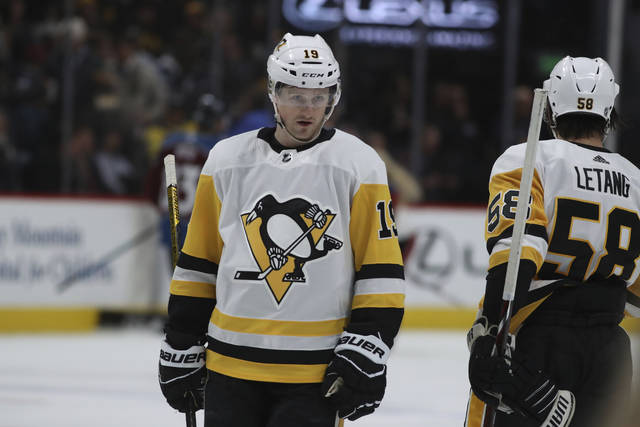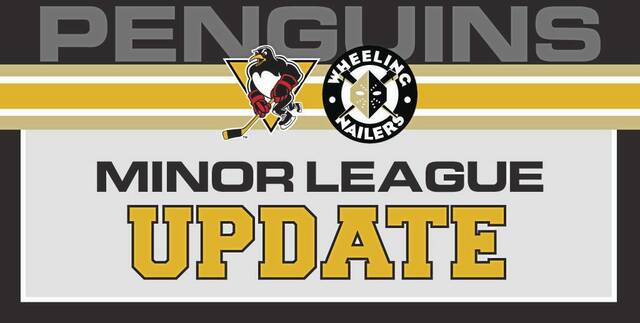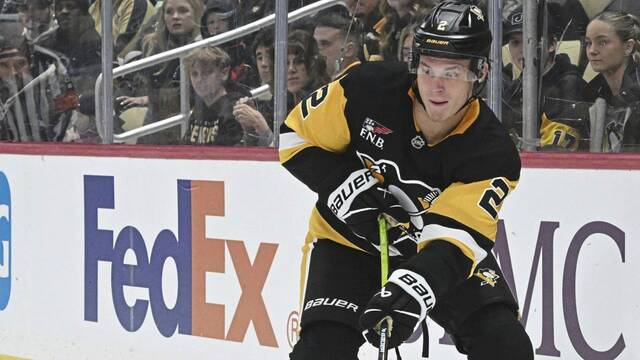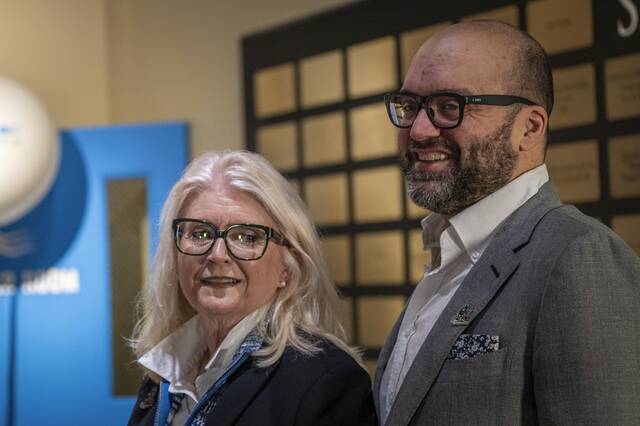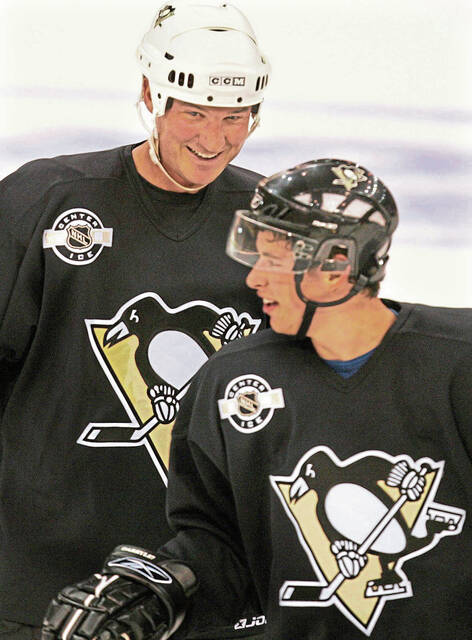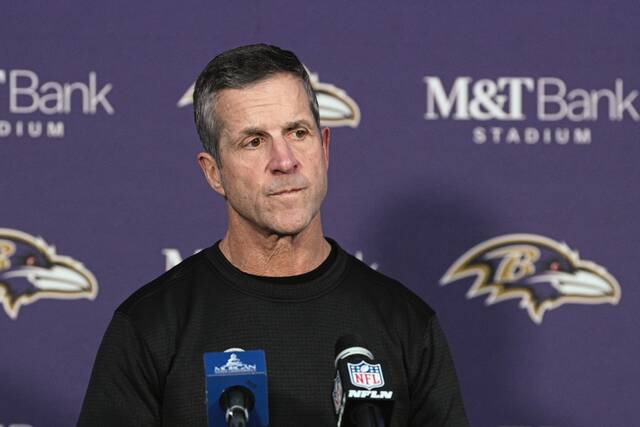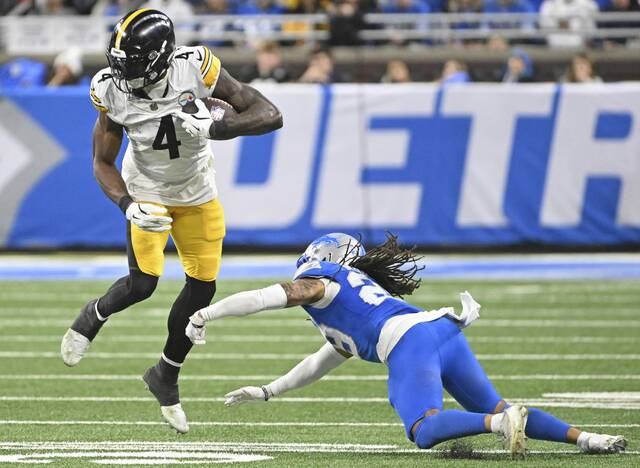GLENDALE, Ariz. — “Hope is not a strategy.”
Those are the words Pittsburgh Penguins coach Mike Sullivan professes to impart on his players when it comes to the chaotic nature of three-on-three overtime.
Truth be told, many of the more conventional or practical constructs don’t apply to the abnormal state of overtime in the NHL of 2020.
With so much open ice, up can be down.
Especially with puck possession.
During the late stages of the Penguins’ 4-3 win against the Colorado Avalanche in Denver’s Pepsi Center, the Penguins willingly surrendered ground … er, ice … when forward Brandon Tanev fed a pass from right corner of the offensive zone to goaltender Matt Murray, approximately 110 feet down at the other end of the rink.
That tactic allowed the Penguins to maintain the puck, change Tanev with forward Jared McCann and reload for another offensive rush with McCann’s fresher legs.
Murray handed the puck off to defenseman John Marino. From behind the Penguins’ net, Marino fed a simple pass to forward Teddy Blueger in the Penguins’ right circle. Turning up ice, Blueger did the bulk of the work on the attack, lugging the puck up the right wing through the neutral zone back into the offensive zone.
As Avalanche defenseman J.T. Compher closed in, Blueger pulled up on the half wall and centered a pass to the slot for McCann, who used Avalanche defenseman Erik Johnson as a screen then snapped a wrister between Johnson’s legs and through the five hole of goaltender Pavel Francouz with 1 minute, 41 seconds left in the period.
(Video courtesy NHL)
“We have talked about dragging pucks out of the offensive zone and using the length of the ice to maintain puck possession,” Sullivan said. “One of the things that we have talked at length about is puck possession, our shot selection, when we shoot. It’s important to keep the puck when you play three on three. We can wear teams down, we can get them tired, we can’t allow them to change, we can have an opportunity to change. There are different strategies that we try to deploy. That was a heads-up play. You throw it back to your goalie, and you have an opportunity to regroup and re-attack. That was a good play by all of those guys.”
Earlier in the overtime frame, Tanev held the puck behind his net and waved at his teammates to make a line change after a scoring opportunity for the Avalanche.
(Video courtesy NHL)
Line changes are a bit more challenging in overtime as teams defend the far side of the bench. That wrinkle in the rule book is intentional as the NHL feels it can create more immediate scoring opportunities.
Such was the case in the Penguins’ 3-2 overtime win against the Montreal Canadiens in the Bell Centre on Jan. 4. Canadiens forward Nick Suzuki went for an inopportune line change, and that opened things for Tanev to score on a rebound.
(Video courtesy NHL)
“We talk a lot about is just trying to out-change the opponent,” Sullivan said. “If we can do that, it gives us a better chance because we can keep fresh people on the ice. They have the ability to recover and react when the puck turns over, either way, offensively or defensively. … The guys are doing a good job with the line changes. They’re not staying out there too long.”
Forward Bryan Rust has plenty of experience changing lines in overtime — and a strategy for doing so properly.
“It’s just a habit,” Rust said. “Constantly reminding yourself when there are good times to change or knowing when to dump the puck or play safe. It’s something you have to have in the back of your mind, and once it becomes habit, it sticks.”
An emphasis on those tactics has led to better success in games that go beyond regulation. In their past five games that have been decided in overtime, the Penguins are 4-1. That’s a considerable improvement over their previous six such games this season, when they went 2-4.
Last season, they were 7-9 in games decided in overtime.
“For us, possession is so important (in) three-on-three (sequences),” Rust said when asked what has led the improved results in overtime. “The more you have the puck, the more you can either cause (the opposing) team to have bad changes. You can out-change teams and try to get opportunities from plays like that. You just wear teams down, and eventually there will be a breakdown. The ability to be patient in that situation is important.”
The geography of shots is key, as well. Penguins coaches have encouraged avoiding shots from bad angles which, if they miss the net, can hit the corners and create a clear or even an outlet for the opposition to initiate an offensive rush.
“If it deflects and goes around the boards, they’ve got a full head of steam coming up the ice,” McCann said. “You’ve got pick your spots.”
Said Rust: “You have to be really selective with your shots, but I don’t think you can be afraid to make something happen. Usually, guys that are out there three-on-three are guys who coaches trust to make things happen but also play hard defensively and get things done. There’s a fine line between being too careless and too careful.”
Another part of possessing the puck? Relying on the goaltender to play it more.
“You’re trying to catch (the opponents) when they’re maybe a little bit tired, and they’ve been out there for a while,” said goaltender Tristan Jarry, the team’s best puck-handler among its netminders. “That’s something (the coaches) want Matt and I to do. If we see that, to keep it going and to maybe catch them.”
The overtime period in Sunday’s 4-3 shootout win against the Arizona Coyotes at Gila River Arena hardly was ideal for the Penguins from a tactical standpoint. They were outshot 5-3 but managed to hold off a spry Coyotes attack and get the contest to an eight-round shootout.
Regardless, they remain satisfied in that they are doing more than simply hoping to win games in overtime.
“We’re changing smart and putting our teammates in good spots,” Blueger said. “Obviously, we’re (handling) the puck a bit more. Not trying to make any ‘hope’ plays. If the opportunity is not there, we’re not afraid to regroup, get fresh guys out there and go at it again. I think three-on-three (sequences), possession is key. So we’re doing a good job of keeping the puck and getting fresh guys out there.”


